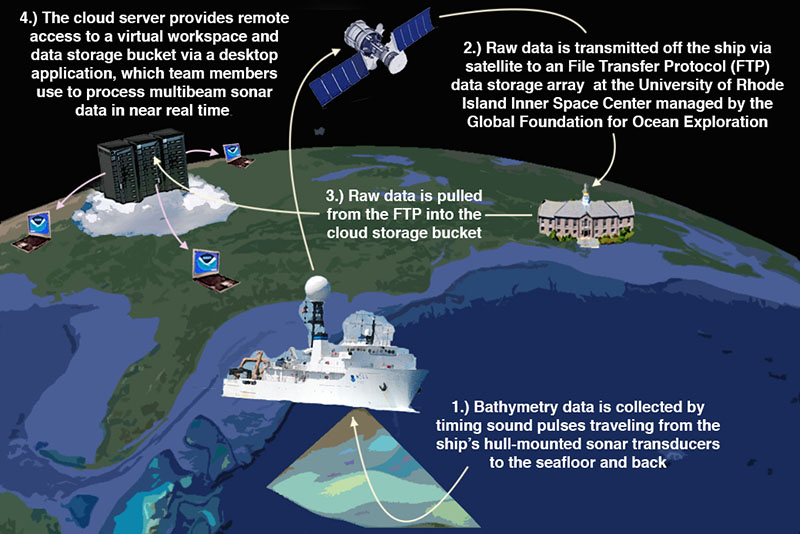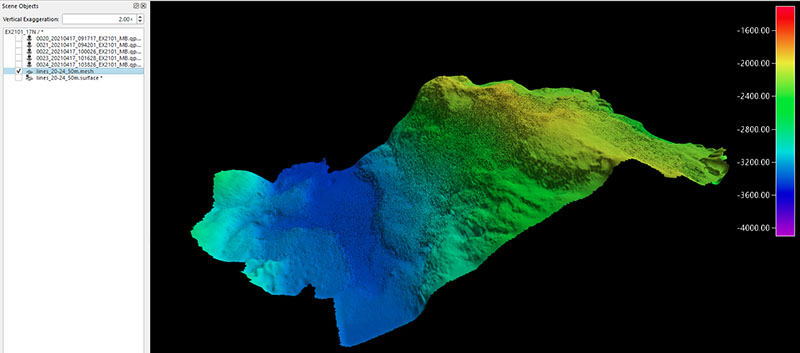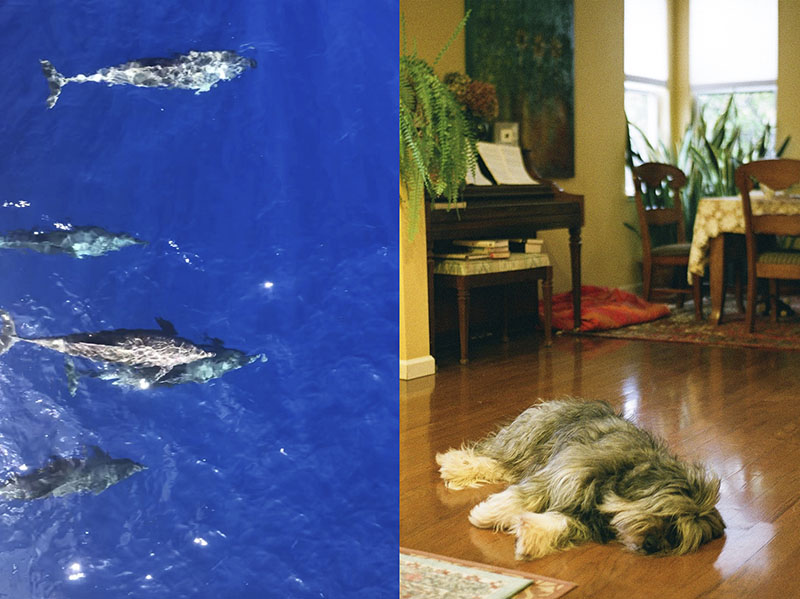
Marcel Peliks, Explorer in Training, NOAA Ocean Exploration
In early 2021, when COVID-19 cases in the United States were on a continuous rise, I received a message from the NOAA Ocean Exploration mapping team lead asking if I’d be interested in joining a mapping expedition on NOAA Ship Okeanos Explorer. With one eye on the email and the other on skyrocketing case counts, it seemed like a hopeful invitation. However, I quickly learned that throughout 2020, the mapping team had increased their remote mapping capabilities, and the expedition would utilize a new cloud-based system for processing data remotely.
As a geologist, I had written off working from home a long time ago, as most of my work depended on data collection in the field, and remote fieldwork was not really possible pre-2020. I especially never considered seafloor mapping as the sub-discipline where collecting data remotely was an option — after all, by definition you need to be out at sea.
However, I should not have been that surprised. The mapping team’s dedication to their work is uncanny; the first and second time I sailed with them on Okeanos Explorer in 2019 proved that. That year, the team persevered through the longest government shutdown in history to still end up with a successful field plan for the summer. Later, in the fall, an unusually powerful series of storms culminated in rollercoaster-worthy sea conditions, and again, the comradery between the team and crew only grew as we shared the misery together.
Still, 2020 really threw this dedicated and resilient team a challenge, and the solution to it was cloud-based mapping. A diagram helps grasp how this is feasible.

A diagram depicting how data is transferred from ship to team members working remotely. Image courtesy of Marcel Peliks. Download largest version (jpg, 435 KB).
The mapping data collected aboard the vessel are continuously transferred ashore via a 40-megabytes-per-second satellite signal via automated transfer scripts. The data are then received on a physical server located at the University of Rhode Island’s Inner Space Center and managed by the Global Foundation for Ocean Exploration. To support a geographically distributed mapping team, the data are then uploaded to a cloud server. By using a virtual computing environment to access the cloud server, the mapping team is able to utilize high processing power in an online setting. The workspace is configured like a normal Windows machine and can be accessed on a home computer from anywhere in the world.

Seafloor data from the depths of the Atlantic to my home computer in California, delivered in near real time. Image courtesy of Marcel Peliks. Download largest version (jpg, 502 KB).
My first two expeditions in 2019, though without a doubt challenging, were extremely rewarding, and I was thrilled by life at sea and collecting seafloor mapping data. For that reason, I immediately accepted the invitation to “sail” remotely. After some logistical thought, however, I began to have doubts…
Would a full shift processing data on the cloud remotely be as interesting and fun as it was to be surrounded by an eclectic crew of seafloor mapping experts onboard a ship at sea? Would traveling from my bed to my desk be as exciting as flying across the country to a completely new city and then sailing off to sea? Would watching my dog napping on the floor be as spectacular as watching dolphins surf the wave at the bow? Undoubtedly, the answer was no. Nevertheless, I was eager to help make this year’s unusual field campaign a success.

Dolphins at the bow versus my dog napping on the floor. One more spectacular than the other, but both undoubtedly cute. Image courtesy of Marcel Peliks. Download largest version (jpg, 1.2 MB).
When the 2021 EM 304 Sea Acceptance Testing and Mapping Shakedown started, I didn’t feel the rolls of the first waves as we left the harbor or watch the land disappear over the horizon and the blue sea take over. Instead, I logged into a cloud account and began navigating the sea of data remotely. Although the physical aspects may not have been as stimulating as being out at sea, what I didn’t realize was how strong the NOAA Ocean Exploration mapping team bond is, regardless of setting. The excitement of mapping previously unmapped regions of the ocean with a motivated crew was still in full force.
I realized that the experience is really about working together to accomplish a mission, and the ability to travel and experience life at sea are just added bonuses. During the cloud-enabled expedition, we successfully established protocols to process multibeam sonar data into the standard products the mapping team generates. I look forward to joining more expeditions remotely, and indeed will be joining the two parts of the 2021 U.S. Blake Plateau Mapping expedition remotely this summer. But, I will also jump at the opportunity to sail onboard again in the future.
Published July 27, 2021.